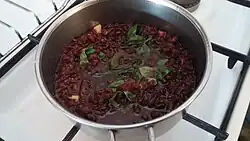Capuliato
The capuliato or capuliatu, is a traditional condiment of Sicilian cuisine based on dried tomatoes, linked, in particular to the territory of the Vittoria Plain, in Free municipal consortium of Ragusa. The original name is capuliato which means minced.[1]
 Capuliato | |
| Type | Condiments, Sauce |
|---|---|
| Place of origin | Italy |
| Region or state | Sicily |
| Serving temperature | Hot or warm |
| Main ingredients | Tomatoes, basil, salt, garlic, chili pepper, oil |
History
Initially in Europe the tomato was used as an ornamental plant and it was only in the 19th century that it spread on a gastronomic level.[2][3]
It is agreed that the capuliato (when referring to the dish as "spaghettata" and not as a condiment, usually, it is also called "capuliata")[4][5] was born and spread from Vittoria,[1][6][7][8][5][4] where since its origins the territory was easily exploitable on an agricultural level.
Among the areas of diffusion of the product, Vittoria has always been by far the one with the greatest production and tradition of the tomato. The city of Vittoria is home to the largest fruit and vegetable markets in Italy and the most important in Italy and Europe for tomatoes.[9] Its only hamlet (frazione) is the seaside locality of Scoglitti. However the territory is very large and in addition to the urban area, it has 45 different contrade, mostly used for greenhouse cultivation.[10]
The capuliato was born when the methods of preserving tomato sauce and greenhouse cultivation of the latter were not yet practiced. The recipe quickly spread to other areas of the province and nearby Gela. As the tomatoes were not available in the winter, they were dried and processed in the warm months, usually July and August, and then conserved to season the pasta and bread throughout the year.[11]
Preparation and use
The tomatoes are first washed, then cut, salted and dried in the sun. Subsequently they are ground, usually with a meat grinder and generally placed in oil, in a marinade that provides basil or oregano, and other flavors in addition depending on the tastes that can be for example garlic, chili pepper.[11] The capuliato is mainly used to season pasta, bread or bruschetta, but also to flavor the stuffed focaccia typical of the ragusano, the scacce.[12]
Most common recipes
The classic pasta al capuliato includes garlic, extra virgin olive oil and capuliato, with the addition of basil or parsley at the end (elements that, however, once were not easily available in winter). It can be enriched with fried bread crumbs, breadcrumbs, grated cheese and other condiments. Long pasta is indicated, the classic spaghetti n ° 5 is usually cooked.[13] The bread is filled with capuliato, extra virgin olive oil and ingredients such as cheese, oregano or basil, anchovies, chili pepper.[14]
Industrial production
There are now several manufacturing companies, especially in Vittoria, the home of the capuliato, thanks to which the product is easily available in delicatessens or supermarkets throughout Sicily, especially in the south-east. The tradition of homemade production still remains strong.[15][16]
See also
Notes
- sicilianpost.it (February 27, 2019). "Alla scoperta del "capuliatu": la conserva siciliana dalla storia" gustosa" (in Italian).
- smithsonianmag.com (June 18, 2013). "Why the Tomato Was Feared in Europe for More Than 200 Years".
- pomodoro.museidelcibo.it. "La storia del pomodoro" (in Italian).
- euge-cucinareperamore.com (August 22, 2011). "Addendum a: spaghetti con il pesto di pomodori secchi, ovvero la Capuliata ragusana" (in Italian).
- unapadellatradinoi.com (August 3, 2016). "CAPULIATA..." (in Italian).
- dallacucinadijo.com (July 16, 2011). "Bigoli con capuliato nduja e zucchine" (in Italian).
- convivium.club. "Il nostro pasto" (in Italian).
- olioextraverginediolivasicilia.com. "Capuliato di pomodori siciliani biologici" (in Italian).
- centrometeosicilia.it (December 7, 2018). "Vittoria (RG), fiore all'occhiello dell'agricoltura siciliana e non solo" (in Italian).
- comunevittoria.gov.it. "Aggiornamento Piano A.R.O. approvato con D.D.G. n. 625 del 22/05/2015" (PDF) (in Italian). Archived from the original (PDF) on 2021-09-25. Retrieved 2020-05-01.
- gelacittadimare.it. "Pomidoro Secchi" (in Italian).
- turismoaragusa.it (August 7, 2012). "Gastronomia della provincia di Ragusa" (in Italian). Archived from the original on 2014-03-20.
- gela.italiani.it (June 13, 2017). "A pasta co' capuliato. L'alternativa alla spaghettata aglio, olio e peperoncino" (in Italian).
- "Pane cunzatu" (in Italian). pomodorisecchi.com. 25 June 2018.
- italreport.it (November 12, 2015). "Vittoria. Boom di visitatori all'Emaia. Il sindaco: in primavera un'altra fiera con-sagra del pomodorino" (in Italian).
- lanostracommediajalesh.wordpress.com (July 1, 2013). "Prodotti tipici della cucina di Vittoria" (in Italian). Archived from the original on March 29, 2022. Retrieved April 30, 2020.